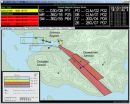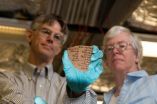(Press-News.org) Contact: David Hosansky
303-497-8611
hosansky@ucar.edu
NCAR/UCAR
Zhenya Gallon, NCAR/UCAR Media Relations
303-497-8607
zhenya@ucar.edu
New airport system facilitates smoother take-offs and landings
BOULDER--For airline passengers who dread bumpy rides to mountainous destinations, help may be on the way. A new turbulence avoidance system has for the first time been approved for use at a U.S. airport and can be adapted for additional airports in rugged settings across the United States and overseas.
The system, developed by the National Center for Atmospheric Research (NCAR), provides information pilots can use to route aircraft away from patches of potentially dangerous turbulence. It uses a network of wind measuring instruments and computational formulas to interpret rapidly changing atmospheric conditions.
The Federal Aviation Administration formally commissioned the system in July for Alaska's Juneau International Airport. NCAR researchers can now turn their attention to adapting the system to other airports that often have notoriously severe turbulence, in areas ranging from southern California and the Mountain West to Norway and New Zealand.
The Juneau system was patterned after a similar system, also designed by NCAR, that has guided aircraft for several years at Hong Kong's heavily trafficked Chek Lap Kok Airport.
"By alerting pilots to areas of moderate and severe turbulence, this system enables them to fly more frequently and safely in and out of the Juneau airport in poor weather," says Alan Yates, an NCAR program manager who helped oversee the system's development. "It allows pilots to plan better routes, helping to reduce the bumpy rides that passengers have come to associate with airports in these mountainous settings."
The system offers the potential to substantially reduce flight delays. In Alaska's capital city, where it is known as the Juneau Airport Wind System or JAWS, it enables the airport to continue operations even during times of turbulence by highlighting corridors of smooth air for safe take-offs and landings.
"The JAWS system has nearly eliminated all the risk of flying in and out of Juneau," says Ken Williams, a Boeing 737 captain and instructor pilot with Alaska Airlines. "I wish the system would be deployed in other airports where there are frequent encounters with significant turbulence, so pilots can get a true understanding of what the actual winds are doing on the surrounding mountainous terrain as you approach or depart."
The project was funded by the Federal Aviation Administration. NCAR is sponsored by the National Science Foundation.
Steep terrain, rough rides
Turbulence has long been a serious concern for pilots approaching and departing airports in steep terrain. Rugged peaks can break up air masses and cause complex and rapidly changing patterns of updrafts and downdrafts, buffeting an aircraft or even causing it to unexpectedly leave its planned flight path.
In Juneau, after several turbulence-related incidents in the early 1990s—including one in which a jet was flipped on its side during flight and narrowly avoided an accident—the FAA imposed strict rules of operation that effectively shut down the airport during times of atmospheric disturbance. The agency then asked NCAR to develop a system that would allow pilots to avoid regions of turbulence. Otherwise, Alaska's capital would be isolated at many times from the rest of the state, since the only way to travel in and out of Juneau is by airplane or boat.
The NCAR team used research aircraft and computer simulations to determine how different wind patterns—such as winds that come from the north over mountains and glaciers and winds that come from the southeast over water—correlated with specific areas of turbulence near the airport. To do this they installed anemometers and wind profilers at key sites along the coast and on mountain ridges. The team has installed ruggedized, heated instruments that can keep functioning even when exposed to extreme cold, wind, and heavy icing conditions.
The Federal Aviation Administration accepted JAWS for operational use this year.
The five anemometer sites and three wind profiler sites around the airport transmit data multiple times every minute. Pilots can get near-real-time information about wind speed and direction, and a visual readout showing regions of moderate and severe turbulence in the airport's approach and departure corridors, from the FAA's Flight Service Station or online at a National Weather Service website.
"Juneau was an extremely challenging case, and we're pleased that the new system met the FAA's high standards," Yates says. "We look forward to exploring opportunities to support development of turbulence avoidance systems at additional airports. Our goal is to improve flying safety and comfort for millions of passengers."
INFORMATION:
The University Corporation for Atmospheric Research manages the National Center for Atmospheric Research under sponsorship by the National Science Foundation. Any opinions, findings and conclusions, or recommendations expressed in this publication are those of the author(s) and do not necessarily reflect the views of the National Science Foundation.
On the Web:
Additional news releases, images, and more:
www.ucar.edu/atmosnews
New airport system facilitates smoother take-offs and landings
2012-09-19
ELSE PRESS RELEASES FROM THIS DATE:
GEOLOGY adds 30 new articles online
2012-09-19
Boulder, Colo., USA – This month, GSA's top geoscience journal, Geology, has posted 30 new articles ahead of print. Locations studied include Bhutan; the James Bay Lowland of Canada; Mount Taranaki, New Zealand; Fort Stanton Cave and Carlsbad Cavern, New Mexico, USA; the Quelccaya Ice Cap, Peru; the Nile Delta; and Mars. Topics include methane hydrates, microbial micro-tunneling, fibrous diamonds, climate change, cosmic rays, and maars. Also in Geology: the first application of CARS microscopy to the geosciences.
Highlights are provided below. GEOLOGY articles published ...
Joint UT study: Reading food labels helps shoppers stay thinner
2012-09-19
KNOXVILLE—Shoppers — particularly women — who take the time to read food labels are thinner than those who don't.
These findings are from a recently released study authored by Steven T. Yen, a University of Tennessee professor in the Institute of Agriculture's Department of Agricultural and Resource Economics, in conjunction with researchers at the University of Santiago de Compostela in Spain, the University of Arkansas and the Norwegian Institute for Agricultural Finance Research.
Women who read food labels weighed nearly 9 pounds less than women who didn't read labels, ...
Surprising demographic shifts in endangered monkey population challenge conservation expectations
2012-09-19
MADISON – At first glance, the northern muriqui monkey is a prime conservation success story.
These Brazilian primates are critically endangered, but in the past 30 years a population on a private reserve has grown from just 60 individuals to some 300, now comprising almost a third of the total remaining animals.
As the population grows, though, it is offering researchers a glimpse into a new phase of recovery as it begins to face the limitations of its habitat. A recent analysis of the factors contributing to this population's tremendous growth reveals surprising trends ...
New tools help nursing homes track and prevent deadly infections
2012-09-19
CHICAGO (September 18, 2012) – The Society for Healthcare Epidemiology of America (SHEA) and Centers for Disease Control and Prevention (CDC) have each released new tools and information to help track deadly healthcare-associated infections (HAIs) in nursing homes and other long-term care settings. Potentially deadly HAIs strike volumes of nursing home residents each year, with best estimates suggesting that up to 2.8 million infections can occur in this population annually.
Published online this week in Infection Control and Hospital Epidemiology, the journal of SHEA, ...
Economic freedom report: US continues slide, drops to 18th
2012-09-19
TALLAHASSEE, Fla. ⎯ The United States, long considered a champion of economic freedom, plunged to No. 18 in new rankings published in the 2012 Economic Freedom of the World, an annual report co-authored by Florida State University economics Professor James Gwartney.
The report is published by Canada's Fraser Institute in cooperation with institutes in 78 other nations and territories. The U.S. publisher is the Cato Institute. The 2012 report, released on Sept. 18, uses 42 different variables derived from sources such as the World Bank and International Monetary ...
Dictionary completed on language used everyday in ancient Egypt
2012-09-19
A dictionary of thousands of words chronicling the everyday lives of people in ancient Egypt — including what taxes they paid, what they expected in a marriage and how much work they had to do for the government — has been completed by scholars at the University of Chicago.
The ancient language is Demotic Egyptian, a name given by the Greeks to denote it was the tongue of the demos, or common people. It was written as a flowing script and was used in Egypt from about 500 B.C. to 500 A.D., when the land was occupied and usually dominated by foreigners, including Persians, ...
Funding for medical research and science programs faces draconian cuts
2012-09-19
Bethesda, MD – A new report from the Office of Management and Budget (OMB) is a stark reminder of the perilous situation facing the medical research and scientific communities unless Congress and the President take action to prevent the pending sequestration. Set in motion by the Budget Control Act of 2011, sequestration would impose automatic cuts on federal funding starting on January 2, 2013. According to OMB, the budget for the National Institutes of Health (NIH) would be reduced by $2.529 billion, the National Science Foundation would lose $586 million, and the Department ...
Notre Dame research could provide new insights into tuberculosis and other diseases
2012-09-19
Researchers Patricia A. Champion and Matthew Champion from the University of Notre Dame's Eck Institute for Global Health have developed a method to directly detect bacterial protein secretion, which could provide new insights into a variety of diseases including tuberculosis.
The Champions point out that bacteria use a variety of secretion systems to transport proteins beyond their cell membrane in order to interact with their environment. For bacterial pathogens like TB these systems transport bacterial proteins that promote interaction with host cells, leading to ...
Engineering a better hip implant
2012-09-19
VIDEO:
University of Iowa researchers have determined that thigh size in obese people is a reason their hip implants are more likely to fail.
Click here for more information.
University of Iowa researchers have determined that thigh size in obese people is a reason their hip implants are more likely to fail.
In a study, the team simulated hip dislocations as they occur in humans and determined that increased thigh girth creates hip instability in morbidly obese patients (those ...
New study confirms erroneous link between XMRV and prostate cancer-contamination was the cause
2012-09-19
A once-promising discovery linking prostate cancer to an obscure retrovirus derived from mice was the result of an inadvertent laboratory contamination, a forensic analysis of tissue samples and lab experiments – some dating back nearly a decade – has confirmed.
The connection, which scientists have questioned repeatedly over the last couple years, was first proposed more than six years ago, when the telltale signature of the virus, known as XMRV, was detected in genetic material derived from tissue samples taken from men with prostate cancer.
Later studies failed ...



